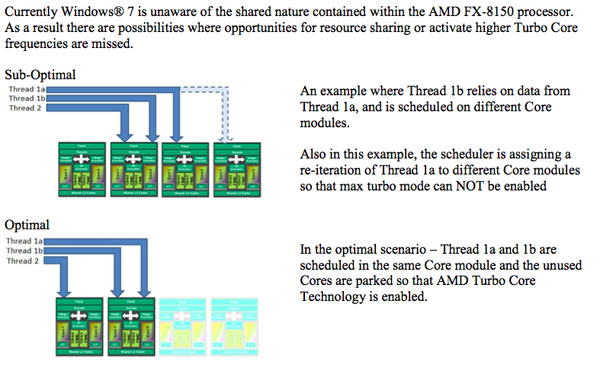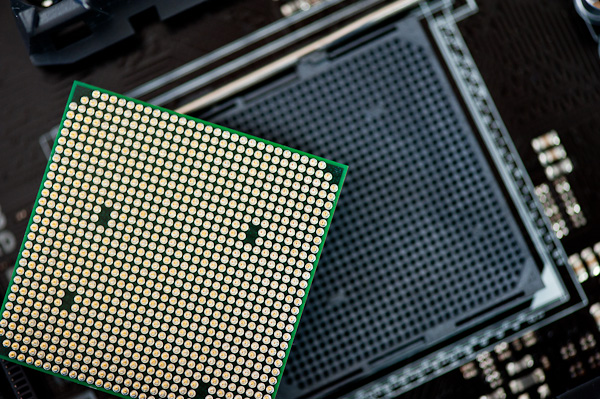The Bulldozer Review: AMD FX-8150 Tested
by Anand Lal Shimpi on October 12, 2011 1:27 AM ESTFinal Words
In many cases, AMD's FX-8150 is able to close the gap between the Phenom II X6 and Intel's Core i5 2500K. Given the right workload, Bulldozer is actually able to hang with Intel's fastest Sandy Bridge parts. We finally have a high-end AMD CPU with power gating as well as a very functional Turbo Core mode. Unfortunately the same complaints we've had about AMD's processors over the past few years still apply here today: in lightly threaded scenarios, Bulldozer simply does not perform. To make matters worse, in some heavily threaded applications the improvement over the previous generation Phenom II X6 simply isn't enough to justify an upgrade for existing AM3+ platform owners. AMD has released a part that is generally more competitive than its predecessor, but not consistently so. AMD also makes you choose between good single or good multithreaded performance, a tradeoff that we honestly shouldn't have to make in the era of power gating and turbo cores.
Bulldozer is an interesting architecture for sure, but I'm not sure it's quite ready for prime time. AMD clearly needed higher clocks to really make Bulldozer shine and for whatever reason it was unable to attain that. With Piledriver due out next year, boasting at least 10-15% performance gains at the core level it seems to me that AMD plans to aggressively address the shortcomings of this architecture. My only concern is whether or not a 15% improvement at the core level will be enough to close some of the gaps we've seen here today. Single threaded performance is my biggest concern, and compared to Sandy Bridge there's a good 40-50% advantage the i5 2500K enjoys over the FX-8150. My hope is that future derivatives of the FX processor (perhaps based on Piledriver) will boast much more aggressive Turbo Core frequencies, which would do wonders at eating into that advantage.

AMD also shared with us that Windows 7 isn't really all that optimized for Bulldozer. Given AMD's unique multi-core module architecture, the OS scheduler needs to know when to place threads on a single module (with shared caches) vs. on separate modules with dedicated caches. Windows 7's scheduler isn't aware of Bulldozer's architecture and as a result sort of places threads wherever it sees fit, regardless of optimal placement. Windows 8 is expected to correct this, however given the short lead time on Bulldozer reviews we weren't able to do much experimenting with Windows 8 performance on the platform. There's also the fact that Windows 8 isn't expected out until the end of next year, at which point we'll likely see an upgraded successor to Bulldozer.

So what do you do if you're buying today? If you have an existing high-end Phenom II system, particularly an X4 970 or above or an X6 of any sort, I honestly don't see much of a reason to upgrade. You're likely better off waiting for the next (and final) iteration of the AM3+ lineup if you want to stick with your current platform. If you're considering buying new, I feel like the 2500K is a better overall part. You get more predictable performance across the board regardless of application type or workload mix, and you do get features like Quick Sync. In many ways, where Bulldozer is a clear win is where AMD has always done well: heavily threaded applications. If you're predominantly running well threaded workloads, Bulldozer will typically give you performance somewhere around or above Intel's 2500K.
I was hoping for Bulldozer to address AMD's weakness rather than continue to just focus on its strengths. I suspect this architecture will do quite well in the server space, but for client computing we may have to wait a bit longer for a more competitive part from AMD. The true culprit for Bulldozer's lackluster single-threaded performance is difficult to track down. The easy answer would seem to be clock speed. We've heard of issues at Global Foundries and perhaps Bulldozer is the latest victim. If AMD's clock targets were 30% higher than Phenom II, it simply didn't make them with the FX-8150. I've heard future derivatives will focus more on increasing IPC indepedent of process technology and clock speed, but if you asked me what was the one limit to success I would say clock speed. As a secondary factor, AMD appeared to make some tradeoffs to maintain a reasonable die size at 32nm. Even then Bulldozer can hardly be considered svelte. I suspect as AMD is able to transition to smaller transistor geometries, it will be able to address some of Bulldozer's physical shortcomings.
The good news is AMD has a very aggressive roadmap ahead of itself; here's hoping it will be able to execute against it. We all need AMD to succeed. We've seen what happens without a strong AMD as a competitor. We get processors that are artificially limited and severe restrictions on overclocking, particularly at the value end of the segment. We're denied choice simply because there's no other alternative. I don't believe Bulldozer is a strong enough alternative to force Intel back into an ultra competitive mode, but we absolutely need it to be that. I have faith that AMD can pull it off, but there's still a lot of progress that needs to be made. AMD can't simply rely on its GPU architecture superiority to sell APUs; it needs to ramp on the x86 side as well—more specifically, AMD needs better single threaded performance. Bulldozer didn't deliver that, and I'm worried that Piledriver alone won't be enough. But if AMD can stick to a yearly cadence and execute well with each iteration, there's hope. It's no longer a question of whether AMD will return to the days of the Athlon 64, it simply must. Otherwise you can kiss choice goodbye.











430 Comments
View All Comments
Ryan Smith - Wednesday, October 12, 2011 - link
Good point. Fixed.Marburg U - Wednesday, October 12, 2011 - link
they have a bloating cache with something wrong insidehttp://www.xbitlabs.com/images/cpu/amd-fx-8150/t5....
npp - Wednesday, October 12, 2011 - link
Sun went an even more extreme route regarding FP performance on its Niagara CPUs - as far as I remember, the first generation chip had a single FPU shared across eight cores. Performance was not even close to a dual-core Core 2 Duo at that time. So that was what I though when I first read about the "module" approach in Bulldozer maybe an year ago - man, this must be geared towards server workloads primary, it will suffer on the desktop. I guess FPU count = core count would have be more appropriate for the FX line.hasu - Wednesday, October 12, 2011 - link
Would this be a good candidate for web server applications because of its excellent multi-threaded performance? How about to host a bunch of Virtual Machines?sep332 - Wednesday, October 12, 2011 - link
I've also been wondering if running a lot of VMs would work better on this CPU. But I don't really know how you'd benchmark that kind of thing. Time and total energy consumption to serve 20,000 web pages from 12 VMs?magnetik - Wednesday, October 12, 2011 - link
I've been waiting for this moment for months and months.Reading the whole thing now...
themossie - Wednesday, October 12, 2011 - link
This processor is worse than the Phenom II X6 for most of my workloads. My next machine will be Sandy/Ivy Bridge.But... we haven't seen this clock ramp up yet. As Anand mentions on page 3 - Remember the initial Pentium 4s? The Williamette 1.4 and 1.5 ghz processors were clearly worse than the competition, to say nothing of the PIII line. In time the P4 consistently beat the much higher IPC AMD processors on most workloads, especially after introducing Hyper-threading. This really does feel like a new Pentium IV! Trying a design based on clock speed and one-upping Intel's hyperthreading by calling 4 '1.5' cores 8 (we hyperthread your hyperthreading!) - it will be a wild ride.
At this point, I don't see anyone beating Intel at process shrink and they're a moving target. But competitive pricing, quick ramp up and a few large server wins can still save the day. Dream of crazy clockspeeds :-)
themossie - Wednesday, October 12, 2011 - link
Upon further reflection...- Expect to see Bulldozer targeted towards servers and consumers who think "8 cores" sounds sexy, at least until clockspeed ramps up.
- Processor performance is not the limiting factor for most consumer applications. AMD will push APUs very heavily, something they can beat Intel at. Piledriver should drive a good price/performance bargain for OEMs, and for laptops may have idle power consumption in shouting distance of Sandy Bridge.
I'm more optimistic about AMD now. But my next machine will still be Sandy Bridge / Ivy Bridge.
wolfman3k5 - Wednesday, October 12, 2011 - link
I see people that say that they'll be waiting for Piledriver. Why not wait for AMD Drillbit, or AMD Dremel? How about AMD Screwdriver or AMD Nailpuller? Tomorrow my 2600K arrives. I'm done. I had a build ready with a ASUS 990FX ready for Bulldozer, but I will "bulldoze" the part back to NewEgg.I must admit, I was worried when I saw the large amounts of L2 cache before the launch. AMD engineers must have been taking the summer off, and decided to throw more cache at the problem. AMD needs a new engineering team. Why the hell can Intel get it right and they can't?
AMD, your CPU engineers are lazy and incompetent. I mean, it only took you "only" four years to get your own version of the Pentium 4.
The bottom line is that its time to fire your lazy retarded and incompetent engineers, and scout for some talent. That's what every other company does that wants to succeed, regardless of the industry. I mean, look at KIA and Hyundai for example, they went out and hired the best designers from Audi and the best engineers they could buy with money. Throw some more money at the problem AMD and solve your problems. And if those lazy fat fucks in Texas that you call engineers don't deliver, look somewhere else. Israel or Russia maybe? Who knows... Just my 2 cents.
IKeelU - Wednesday, October 12, 2011 - link
I know nothing of AMD employee's work ethic, but...their problems may have nothing to do with raw technical talent. But you are right about one thing - throwing money at a problem can be helpful, and that's likely why Intel has succeeded for so long. Intel has a lot of cash, and a lot of assets (such as equipment). They can afford the best design/debugging tools (whether they buy'em or make'em), which makes it much easier to develop a top product given the same amount of microchip engineering talent.And just because they're based in Texas doesn't mean their staff is all-American. Like most US tech firms, quite a bit of their talent was probably imported.